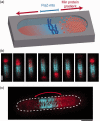Artificial cell mimics as simplified models for the study of cell biology
- PMID: 28580796
- PMCID: PMC5528198
- DOI: 10.1177/1535370217711441
Artificial cell mimics as simplified models for the study of cell biology
Abstract
Living cells are hugely complex chemical systems composed of a milieu of distinct chemical species (including DNA, proteins, lipids, and metabolites) interconnected with one another through a vast web of interactions: this complexity renders the study of cell biology in a quantitative and systematic manner a difficult task. There has been an increasing drive towards the utilization of artificial cells as cell mimics to alleviate this, a development that has been aided by recent advances in artificial cell construction. Cell mimics are simplified cell-like structures, composed from the bottom-up with precisely defined and tunable compositions. They allow specific facets of cell biology to be studied in isolation, in a simplified environment where control of variables can be achieved without interference from a living and responsive cell. This mini-review outlines the core principles of this approach and surveys recent key investigations that use cell mimics to address a wide range of biological questions. It will also place the field in the context of emerging trends, discuss the associated limitations, and outline future directions of the field. Impact statement Recent years have seen an increasing drive to construct cell mimics and use them as simplified experimental models to replicate and understand biological phenomena in a well-defined and controlled system. By summarizing the advances in this burgeoning field, and using case studies as a basis for discussion on the limitations and future directions of this approach, it is hoped that this minireview will spur others in the experimental biology community to use artificial cells as simplified models with which to probe biological systems.
Keywords: Artificial cells; biomimetics; biophysics; synthetic biology.
Figures




References
-
- Steinberg-Yfrach G, Rigaud J-L, Durantini EN, Moore AL, Gust D, Moore TA. Light-driven production of ATP catalysed by F0F1-ATP synthase in an artificial photosynthetic membrane. Nature 1998; 392: 479–82. - PubMed
-
- Lentini R, Santero SP, Chizzolini F, Cecchi D, Fontana J, Marchioretto M, Del Bianco C, Terrell JL, Spencer AC, Martini L, Florin M, Assfalg M, Serra DS, Bentley WE, Mansey SS. Integrating artificial with natural cells to translate chemical messages that direct E. coli behaviour. Nature Communications 2014; 5: 4012–4012. - PMC - PubMed
-
- Elani Y, Law RV, Ces O. Protein synthesis in artificial cells: using compartmentalisation for spatial organisation in vesicle bioreactors. Physical Chemistry Chemical Physics 2015;17;15534–7. - PubMed
-
- Elani Y, Law RV, Ces O. Vesicle-based artificial cells as chemical microreactors with spatially segregated reaction pathways. Nature Communications 2014; 5: 5305–5305. - PubMed
Publication types
MeSH terms
LinkOut - more resources
Full Text Sources
Other Literature Sources

